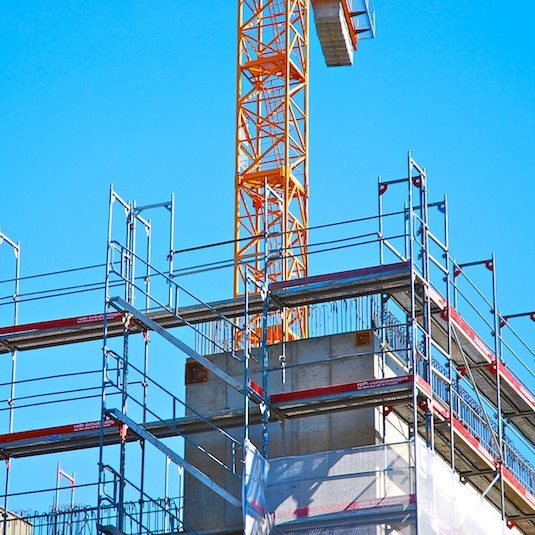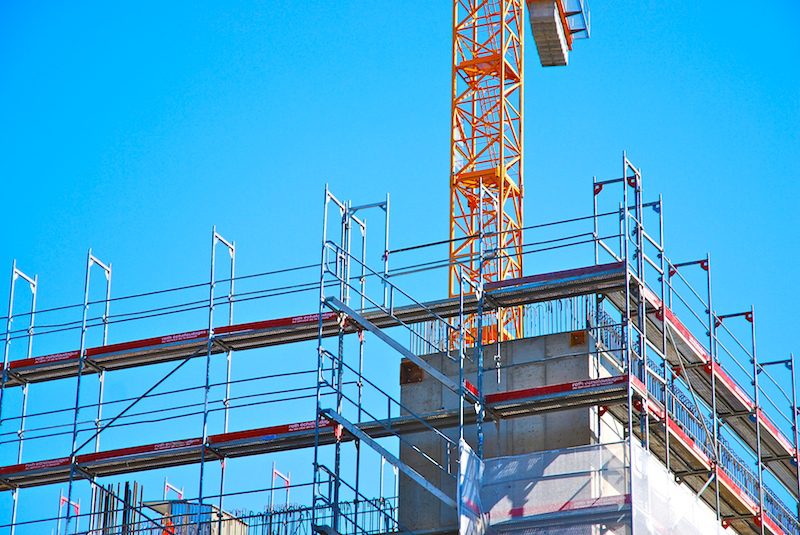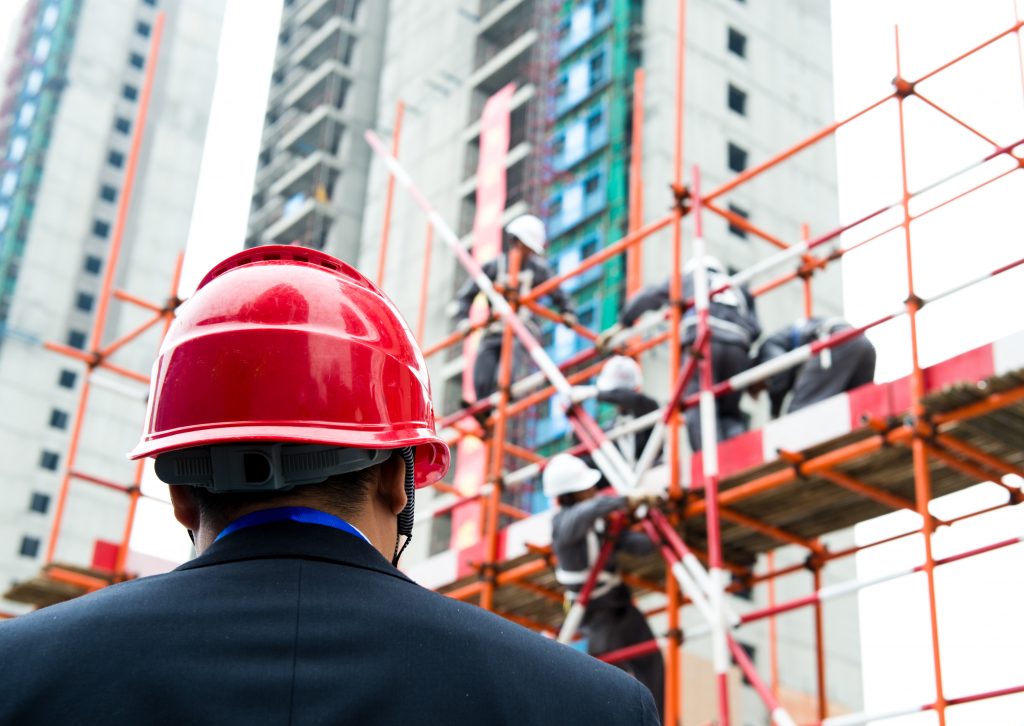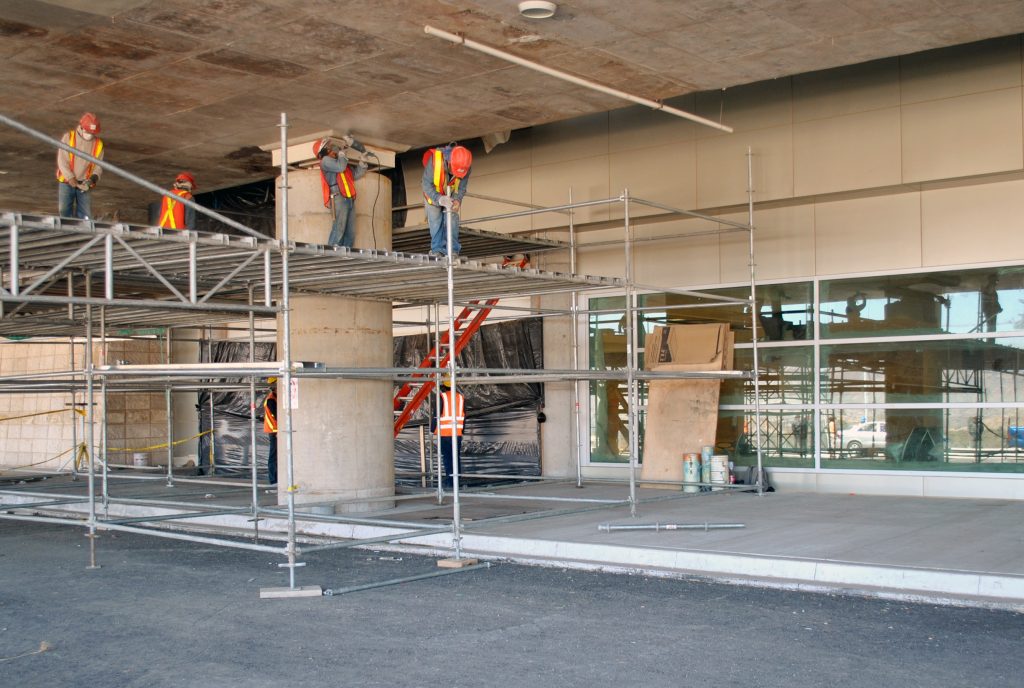
Safety Spotlight: Scaffolding

Written by: Virginia McCormick, NES, Inc.

Scaffolding can often pose unique and life-threatening hazards to workers.
The Common Use of Scaffolding
There are few practices as ubiquitous to the construction industry as scaffolding. These temporary structures are typically used to aid in the construction and/or maintenance of buildings. Scaffolding (also referred to as staging) is widely used to gain access to areas that would otherwise be difficult to reach. An estimated 2.3 million construction workers, or 65 percent of the construction industry, work with scaffolding.
The usage of temporary structures to reach new heights has been around for a very long time: paintings recovered from Roman tombs illustrate the use of ancient scaffold methods for building aqueducts, and the famous caves of Lascaux feature wall sockets that suggest primitive scaffolding was used to help our early ancestors reach new surfaces to paint upon. Scaffolding usage has persisted through human advancement and is likely to continue into the foreseeable future.
While modern scaffolding materials and methods likely keep our workers safer than aqueduct builders or caveman artists, contemporary structures still pose unique – and potentially life-threatening – dangers. Workers are encouraged to not only understand the federal and state standards associated with scaffolding, but also to implement those safety standards in practice.
Scaffolding Continues to Top Yearly Violations Lists
As NES reported on in January, scaffold violations came in third on federal OSHA’s top 10 list of cited violation for 2018. It could also be argued that scaffolding violations may have played a role in the first, Fall Protection – General Requirements (29 CFR 1926.501), and eighth, Fall Protection – Training Requirements (29 CFR 1926.503), spots on the top 10 list. In fact, according to OSHA, the most common form of construction industry scaffolding violation in 2018 was related to fall protection in aerial lifts.
According to the Bureau of Labor Statistics’ Census of Fatal Occupational Injuries, approximately 4,500 injuries and over 60 deaths occur every year as a result of scaffold-related accidents, and 72 percent of workers injured in scaffold accidents attributed the accident to improper fall protection, planking or support giving way, or being struck by a falling object. In addition, common scaffold hazards can include structural flaws such as overloading or unsecured bracing and electrical hazards such as the scaffold being erected too close to power lines.
As scaffolding is temporary, it is regularly being dismantled, moved, and reinstalled. Each time this occurs presents the potential for structural hazards to be introduced. Improper construction of scaffold can lead to falling components or complete collapse of the structure – both of which can be fatal.

Many states have scaffolding safety requirements that must be met in addition to federal OSHA standards.
Scaffolding Regulations: Federal & State
Federal OSHA scaffolding regulations primarily come from Code of Federal Regulations, Title 29, §1926, Subpart L (29 CFR 1926 Subpart L). These regulations are specific to the construction industry. OSHA’s scaffold standard covers several key points, including fall protection, capacity limits, and inspections.
Workers more than 10 feet above a lower level must be protected by a personal fall arrest system, a guardrail system, or both (29 CFR 1926.451(g)(1)). A personal fall arrest system will stop a worker from hitting a lower surface after a fall occurs, while a guardrail will help prevent a fall from occurring in the first place.
Scaffold is required to support at least 4 times the maximum intended load, including both workers and materials (29 CFR 1926.451(a)(1) and (3)). A competent person must inspect the scaffolding before each work shift and after any event that might affect the structural integrity (29 CFR 1926.451(f)(3)). A more in-depth review of the federal OSHA standard can be accessed through OSHA’s publicly available guide Scaffolding Use in the Construction Industry.
In addition to 29 CFR 1926 Subpart L, employers in California must also adhere to the California Code of Regulations, Title 8, §1637 (8 CCR 1637). California has generally adopted federal standards for scaffolds, and California’s plan is one of 25 state and territory scaffold safety plans that has been approved by OSHA. Cal/OSHA has many publications available on scaffolding safety, which can be accessed through the organization’s website.

While most can understand the dangers of tall scaffolding, even low-level scaffold can be dangerous.
Scaffolding Training Keeps Workers Safe
Scaffolding is often dismissed as consisting of unsightly structures that cause noise and are a nuisance to the general population. However, scaffold can also be a signal that progress is being made and times are changing. And along with changing times come changing safety regulations, and workers are encouraged to keep up with training to stay apprised of proper worksite safety measures.
Scaffold training keeps incidents low and workers safe. Training should be provided by a qualified person and prior to scaffolding use. The training should include proper use of the scaffold, how to handle materials, and the load capacities of the scaffold.
Training should be conducted regularly. Scaffold use is very common in the construction industry, which means training sometimes gets overlooked or rushed. Workers can fall into the dangerous mindset that they don’t need training because they are already regularly exposed to scaffolding. This can lead to complacency, lapses in judgment, or cutting corners – all of which can result in serious worksite problems. Regular safety training helps to ensure that workers take safety measures seriously.
Training also instills good safety practices such as the proper use of personal protective equipment, mindfulness of coworkers, and inspection requirements when erecting, dismantling, or moving scaffolding.
“Traditional approaches are often reactive – that is, actions are taken only after a worker is injured or becomes sick, a new standard or regulation is published, or an outside inspection finds a problem that must be fixed. Finding and fixing hazards before they cause injury or illness is a far more effective approach. Doing so avoids the direct and indirect costs of worker injuries and illnesses, and promotes a positive work environment.” – Recommended Practices for Safety & Health Programs in Construction, OSHA.
NES and Scaffold Safety
NES can help your business or agency with its scaffold and fall protection training or consulting needs. For more information about our environmental health & safety training and consulting capabilities and how to remain in compliance with applicable rules and regulations, contact NES at 916-353-2360 / 1-800-NES-ADVISE (1-800-637-2384) or office@nesglobal.net.
References:
Roman Aqueducts: Tools and Scaffolding
Art Encyclopedia: Lascaux Cave Paintings (c.17,000 BCE)
OSHA: Most Frequently Cited Serious Violations: Construction Industry FY 2018
OSHA: A Guide to Scaffold Use in the Construction Industry
OSHA: Standard Interpretations: Standard Number: 1926.451(f)(6) 1926.955
OSHA: Accident, Scaffold Collapse
Cal/OSHA: Guide for Working Safely with Supported Scaffolds
New York Times Article: Sidewalk Scaffolding, the Unwanted Neighbor, Is Under Scrutiny
OSHA: Recommended Practice for Safety and Health Programs
OSHA: Recommended Practices for Safety & Health Programs in Construction
